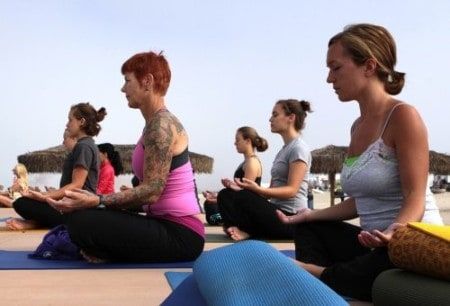Yoga practice to strengthen body and mind
A complete yoga practice includes three elements. These will have a positive effect on numerous aspects of everyday life when practiced regularly. Not only the physical fitness will increase, but also concentration and patience will be strengthened by the yoga practice.
The general tolerance to outside influences such as hectic or negative energies is amazingly increased and facilitates daily activities. The immune system is stabilized and the senses are strengthened.
Those who follow a well-structured yoga practice on a regular basis can notice changes after just a few weeks. Discipline is required, however, if physical progress is to be noted.
The traditional practice, which has been passed down from Indian tradition for decades, consists of the so-called asana practice, pranayama practice and meditation.
The entry into the yoga practice – the yoga training
Asana practice is the most widespread element in the Western world and is offered in various fitness centers and yoga studios. It is also particularly beneficial that no expensive equipment is required. Comfortable clothes and a yoga mat are sufficient.
In the search for helps a post on onlin-fitness-coaching.com about the best yoga mats and current tests. The guidebook explains what makes a good yoga mat.
The health benefits of yoga begin with exercising and stretching muscles and tendons because it increases circulation in the body.
Beginners are slowly introduced to holding unusual postures through simple exercises, and after a short time the body gradually becomes accustomed to the positive changes of these postures.
Deep breathing during the asanas releases tension in the body. Muscles that are not usually used in other activities are suddenly engaged and stimulate all the processes in the practitioner’s system.
The opening of shoulders and hips are the first big step to move into the advanced routine after intensive regular practice.
The transition to advanced yoga practice
With a moderately difficult routine, new positions are practiced slowly and with a lot of patience, and by strengthening especially the back muscles, initially difficult postures become easier and easier and contribute to the overall well-being. The spine is stretched and strengthened, giving the practitioner a better backbone, even figuratively.
In addition to the developments already mentioned, the benefits in the digestive tract are also not to be overlooked. By rotating the upper body, combustion is stimulated and the digestive system is balanced.

Yoga for experienced practitioners
Advanced practice of yoga asana require years of training of body and mind. In an advanced yoga practice not only the physical condition is decisive, but also the mental stability.
Regular practice of this routine has a massive impact on physical vitality and general health. Of course, such exercises must be performed under the strict supervision of a professional instructor who knows about all the functions and effects of the various asanas on the body.
Balance for body and mind
Balance exercises are already practiced in the first yoga classes for beginners and are indispensable for a stable and profitable yoga practice over time.
The cerebral hemispheres are trained and cross connections for the motor movements are created. This was recently reported in the German Medical Journal.
Whether in simple standing balances or inverted arm postures, the body and mind are challenged and the inner and outer focus is highly stimulated and trained. The ideal use of gravity is an art and requires concentration – but is possible for old and young.
Breathing exercises for concentration and calm
The second and equally important aspect of the daily yoga practice is the so-called pranayama. Exercises such as transverse breathing direct concentration inward. Thoughts and impulses are calmed down and the focus is on the most important function of the body – breathing.
Breathing is often forgotten and many people breathe too hastily due to stress or other influences, thus straining natural sensations and being overwhelmed with actions and/or reactions of everyday life.
Conscious inhalation and exhalation relieves the nervous system and gives the practitioner the unique sensation of feeling and appreciating the essential act of breathing.
These exercises expand the lungs and chest and in turn enrich the practitioner with physical flexibility.
Meditation as an extended yoga practice
The third and last aspect is meditation. In traditional Indian practice, yoga asana and pranayama are practiced as preparation for meditation. Sitting in the lotus position is necessary for yoginis to let the energy cycle flow freely.
Preparation by stretching the legs and spine during yoga asana, which increase the flexibility of the hips and knees to the maximum, are therefore necessary for long meditation sessions.
